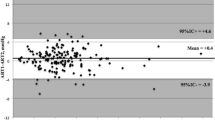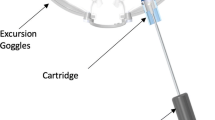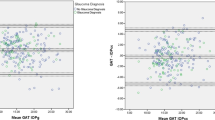Abstract
Applanation resonance tonometry (ART) has been shown in a number of studies to be useful for measuring intraocular pressure (IOP). Data from in vitro laboratory bench testing, where the sensor was carefully centralised onto the cornea, has been very consistent with good precision in the determination of IOP. However, in a clinical study the unavoidable off-centre placement of the sensor against the cornea resulted in a reduced precision. The aim of this study was to evaluate a new design of the sensor with a symmetric sensor probe and a contact piece with a larger diameter. Two in vitro porcine eye experimental set-ups were used. One bench-based for examining position dependence and one biomicroscope-based set-up, simulating a clinical setting, for evaluating IOPART precision at seven different pressure levels (10–40 mmHg), set by connecting a saline column to the vitreous chamber. The reference IOP was recorded using a pressure transducer. There was no significant difference between four positions 1 mm off centre and the one centre position. The precision of the ART as compared with the reference pressure was ±1.03 mmHg (SD, n=42). The design improvement has enhanced the precision of the ART in the biomicroscope set-up to be in parity with bench test results from a set-up using perfect positioning. This indicates that off-centre positioning was no longer a major contributor to the deviations in measured IOP. The precision was well within the limits set by ISO standard for eye tonometers. Therefore, a larger in vivo study on human eyes with the ART should be performed.







Similar content being viewed by others
References
Bafa M, Lambrinakis I, Dayan M, Birch M (2001) Clinical comparison of the measurement of the IOP with the ocular blood flow tonometer, the Tonopen XL and the Goldmann applanation tonometer. Acta Ophthalmol Scand 79:15–18
Eisenberg DL, Sherman BG, Mckeown CA, Schuman JS (1998) Tonometry in adults and children. A manometric evaluation of pneumatonometry, applanation, and TonoPen in vitro and in vivo. Ophthalmology 105:1173–1181
Eklund A, Bergh A, Lindahl OA (1999) A resonator sensor for evaluation of prostate tissue composition and hardness. In: 11th Nordic–Baltic conference on biomedical engineering, vol 37, MBEC, Tallinn, Estonia, pp 181–182
Eklund A, Backlund T, Lindahl OA (2000) A resonator sensor for measurement of intraocular pressure—evaluation in an in vitro pig-eye model. Physiol Meas 21:355–367
Eklund A, Hallberg P, Lindén C, Lindahl OA (2003) Applanation resonance sensor for measuring intraocular pressure—a continuos force and area measurement method. Invest Ophthalmol Vis Sci 44:3017–3024
Eklund A, Lindén C, Backlund T, Andersson B, Lindahl OA (2003) Evaluation of applanation resonator sensors for intraocular pressure measurement, results from clinical and in vitro studies. Med Biol Eng Comput 41:190–197
Goldmann H (1957) Applanation tonometry. In: Newell FW (ed) Glaucoma. Transactions of the second conference. Jr. Foundation, Josiah Macy, pp 167–220
Hallberg P, Lindén C, Lindahl OA, Bäcklund T, Eklund A (2004) Applanation resonance tonometry for intraocular pressure in humans. Physiol Meas 25:1053–1065
Hallberg P, Lindén C, Lindahl OA, Bäcklund T, Eklund A (2005) Comparison of Goldmann applanation and applanation resonance tonometry in a vertical in vitro porcine-eye model. J Med Eng Technol (In press)
Heijl A, Leske MC, Bengtsson B, Hyman L, Hussein M (2002) Reduction of intraocular pressure and glaucoma progression: results from the Early Manifest Glaucoma Trial. Arch Ophthalmol 120:1268–1279
Kontiola AI (2000) A new induction-based impact method for measuring intraocular pressure. Acta Ophthalmol Scand 78:142–145
Omata S, Terunuma Y (1991) Development of new type tactile sensor for detecting hardness and/or softness of an object like the human hand. In: 6th international conference of solid-state sensors and actuators, San Francisco, pp 868–871
Schmidt T (1957) Zur Applanationtonometri an der spaltlampe. Ophthalmologica 133:337–342
Sommer A (1989) Intraocular pressure and glaucoma. Am J Ophthalmol 107:186–188
Whitacre MM, Stein R (1993) Sources of error with use of Goldmann-type tonometers. Surv Ophthalmol 38:1–30
Acknowledgements
The authors would like to thank Michael Hansson, Department of ophthalmology, University Hospital, Umeå, for skilful measurements. The study was supported by grants from the Objective 1 Norra Norrland - EU structural fund.
Author information
Authors and Affiliations
Corresponding author
Rights and permissions
About this article
Cite this article
Hallberg, P., Lindén, C., Bäcklund, T. et al. Symmetric sensor for applanation resonance tomometry of the eye. Med Bio Eng Comput 44, 54–60 (2006). https://doi.org/10.1007/s11517-005-0005-1
Received:
Accepted:
Published:
Issue Date:
DOI: https://doi.org/10.1007/s11517-005-0005-1




